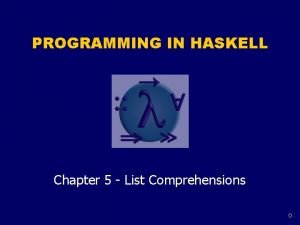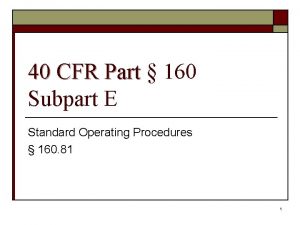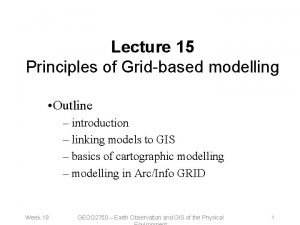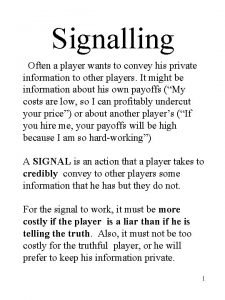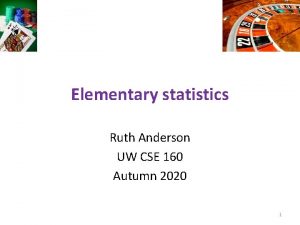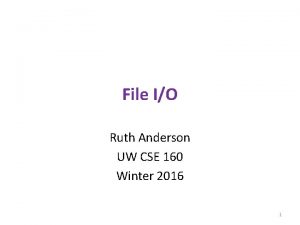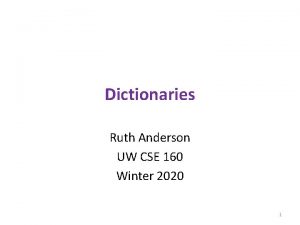List comprehensions Ruth Anderson UW CSE 160 Autumn





![Types of comprehensions List [i * 2 for i in range(3)] Set {i * Types of comprehensions List [i * 2 for i in range(3)] Set {i *](https://slidetodoc.com/presentation_image_h2/480748fecda59898d5c829ca83d5ab5f/image-6.jpg)












- Slides: 18

List comprehensions Ruth Anderson UW CSE 160 Autumn 2020

Three Ways to Define a List • Explicitly write out the whole thing: squares = [0, 1, 4, 9, 16, 25, 36, 49, 64, 81, 100] • Write a loop to create it: squares = [] for i in range(11): squares. append(i * i) • Write a list comprehension: squares = [i * i for i in range(11)] • A list comprehension is a concise description of a list • A list comprehension is shorthand for a loop

Two ways to convert Centigrade to Fahrenheit ctemps = [17. 1, 22. 3, 18. 4, 19. 1] With a loop: ftemps = [] for c in ctemps: f = celsius_to_farenheit(c) ftemps. append(f) With a list comprehension: ftemps = [celsius_to_farenheit(c) for c in ctemps] The comprehension is usually shorter, more readable, and more efficient

Syntax of a comprehension [(x, y) for x in seq 1 for y in seq 2 if sim(x, y) > threshold] expression for clause (required) assigns value to the variable x something that can be iterated zero or more additional for clauses zero or more if clauses

Semantics of a comprehension result = [(x, y) for x in seq 1 for y in seq 2 if sim(x, y) > threshold] result = [] for x in seq 1: for y in seq 2: if sim(x, y) > threshold: result. append((x, y)) … use result …
![Types of comprehensions List i 2 for i in range3 Set i Types of comprehensions List [i * 2 for i in range(3)] Set {i *](https://slidetodoc.com/presentation_image_h2/480748fecda59898d5c829ca83d5ab5f/image-6.jpg)
Types of comprehensions List [i * 2 for i in range(3)] Set {i * 2 for i in range(3)} Dictionary { key: value for item in sequence …} {i: i * 2 for i in range(3)}

Cubes of the first 10 natural numbers Goal: Produce: [0, 1, 8, 27, 64, 125, 216, 343, 512, 729] With a loop: cubes = [] for x in range(10): cubes. append(x ** 3) With a list comprehension: cubes = [x ** 3 for x in range(10)]

Powers of 2: ( 20 through 210 ) Goal: [1, 2, 4, 8, 16, 32, 64, 128, 256, 512, 1024] powers = [2 ** i for i in range(11)]

Lengths of elements of a list Goal: Write a list comprehension that computes the length of each string in the list colors = ["red", "blue", "purple", "gold", "orange"] lengths = [**your expression goes here**] [3, 4, 6]

Even elements of a list Goal: Given an input list nums, produce a list of the even numbers in nums = [3, 1, 4, 1, 5, 9, 2, 6, 5] evens = [**your expression goes here**] [4, 2, 6]

Dictionary of squares Goal: Given an input list nums, produce a dictionary that maps each number to the square of that number. nums = [3, 1, 4, 5, 9, 2, 6, 7] square_dict = {**your expression goes here**}

Normalize a list num_list = [6, 4, 2, 8, 9, 10, 3, 2, 1, 3] total = sum(num_list) With a loop: for i in range(len(num_list)): num_list[i] = num_list[i] / total With a list comprehension: num_list = [num / total for num in num_list]

Dice Rolls Goal: A list of all possible dice rolls. With a loop: rolls = [] for r 1 in range(1, 7): for r 2 in range(1, 7): rolls. append((r 1, r 2)) With a list comprehension: rolls = [(r 1, r 2) for r 1 in range(1, 7) for r 2 in range(1, 7)]

All above-average 2 -die rolls Goal: Result list should be a list of 2 -tuples: [(2, 6), (3, 5), (3, 6), (4, 4), (4, 5), (4, 6), (5, 3), (5, 4), (5, 5), (5, 6), (6, 2), (6, 3), (6, 4), (6, 5), (6, 6)] [(r 1, r 2) for r 1 in range(1, 7) for r 2 in range(1, 7) if r 1 + r 2 > 7] OR [(r 1, r 2) for r 1 in range(1, 7) for r 2 in range(8 - r 1, 7)]

Sum of above-average 2 -die rolls Goal: Result list should be a list of integers: [r 1 + r 2 for r 1 in range(1, 7) for r 2 in range(1, 7) if r 1 + r 2 > 7] [8, 8, 9, 10, 11, 12] Remove Duplicates: Use Set Comprehensions {r 1 + r 2 for r 1 in range(1, 7) for r 2 in range(1, 7) if r 1 + r 2 > 7} {8, 9, 10, 11, 12}

Making a Grid Goal: A grid were each element is the sum of it's row # and column #. (e. g. [[0, 1, 2], [1, 2, 3]]) With a loop: grid = [] for i in range(2): row = [] for j in range(3): row. append(i + j) grid. append(row) With a list comprehension: grid = [[i + j for j in range(3)] for i in range(2)]

A word of caution List comprehensions are great, but they can get confusing. Err on the side of readability. nums = [n for n in range(100) if sum([int(j) for j in str(n)]) % 7 == 0] or nums = [] for n in range(100): digit_sum = sum([int(j) for j in str(n)]) if digit_sum % 7 == 0: nums. append(n)

A word of caution List comprehensions are great, but they can get confusing. Err on the side of readability. nums = [n for n in range(100) if sum([int(j) for j in str(n)]) % 7 == 0] or def sum_digits(n): digit_list = [int(i) for i in str(n)] return sum(digit_list) nums = [n for n in range(100) if sum_digits(n) % 7 == 0]
 Haskell list comprehension
Haskell list comprehension 65 in 30 u kaçtır
65 in 30 u kaçtır Smt 160-30
Smt 160-30 12vac35-105-160
12vac35-105-160 Wac 296-800-160
Wac 296-800-160 Anticorps anti-nucléaire positif moucheté
Anticorps anti-nucléaire positif moucheté Konica minolta bizhub 160
Konica minolta bizhub 160 Parafrasi il canto delle sirene dal verso 160
Parafrasi il canto delle sirene dal verso 160 Emc dd620
Emc dd620 40 cfr 160
40 cfr 160 Carolina windom antenna
Carolina windom antenna 160 5th ave new york ny 10010
160 5th ave new york ny 10010 What does similar mean
What does similar mean El doble del exceso de un numero aumentado en 5
El doble del exceso de un numero aumentado en 5 6280/160
6280/160 Capr 160-1
Capr 160-1 Nyatakan nilai dari sin 160 derajat + sin 20 derajat adalah
Nyatakan nilai dari sin 160 derajat + sin 20 derajat adalah Psalm 119:160
Psalm 119:160 160/60
160/60
